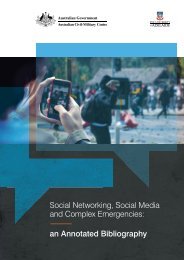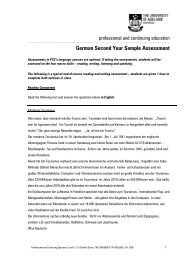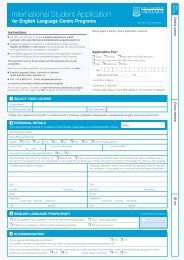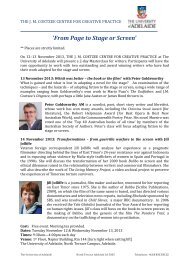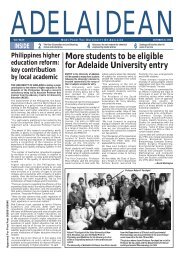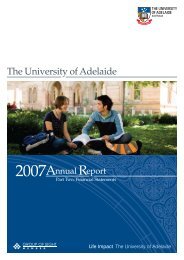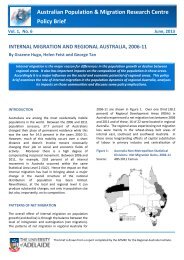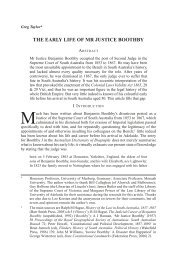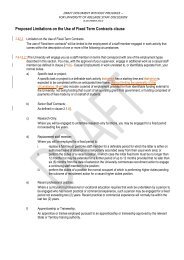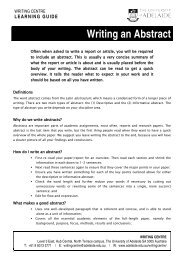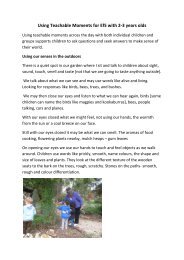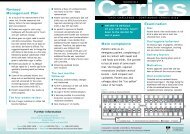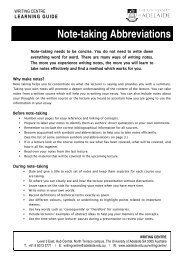Unbridling the Tongues of Women - The University of Adelaide
Unbridling the Tongues of Women - The University of Adelaide
Unbridling the Tongues of Women - The University of Adelaide
You also want an ePaper? Increase the reach of your titles
YUMPU automatically turns print PDFs into web optimized ePapers that Google loves.
<strong>Unbridling</strong> <strong>the</strong> tongues <strong>of</strong> women<br />
Much <strong>of</strong> that activity emanated from Hull House which Jane Addams and Ellen<br />
Starr had founded in 1889 on <strong>the</strong> model <strong>of</strong> Toynbee Hall in <strong>the</strong> east end <strong>of</strong> London.<br />
It was intended to provide occupation for <strong>the</strong> earliest generation <strong>of</strong> female college<br />
graduates in <strong>the</strong> United States by inviting <strong>the</strong>m to live among <strong>the</strong> poor and labouring<br />
classes, participating in <strong>the</strong>ir daily lives and industrial struggles. Through her<br />
work at Hull House, Jane Addams became known as <strong>the</strong> founder <strong>of</strong> modern American<br />
settlement work, and <strong>the</strong> centre <strong>of</strong> <strong>the</strong> people who would come to be labelled<br />
‘<strong>the</strong> social feminists’; women who were also active in labour and socialist struggles<br />
referred to <strong>the</strong>m as ‘<strong>the</strong> allies’. 6 Spence visited Hull House and developed considerable<br />
admiration for Jane Addams’s work. 7 At <strong>the</strong> World Fair in Chicago, she may<br />
not have been aware <strong>of</strong> <strong>the</strong> links being forged between Hull House and <strong>the</strong> garment<br />
workers’ struggle, but <strong>the</strong>re she met Susan B. Anthony, five years older than she was,<br />
and by that time president <strong>of</strong> <strong>the</strong> National American <strong>Women</strong>’s Suffrage Association. 8<br />
I have not found any evidence to support Spence’s claim that she converted Susan B.<br />
Anthony to effective voting. 9 Anthony was an extremely single-minded campaigner<br />
for women’s suffrage. 10 As had John Stuart Mill nearly 30 years earlier, she may well<br />
have considered that Spence’s energies would be more fruitfully focussed in <strong>the</strong> suffrage<br />
struggle, a struggle which was increasingly preoccupying all <strong>of</strong> <strong>the</strong> groups and<br />
individuals <strong>of</strong> <strong>the</strong> <strong>Women</strong>’s Movement.<br />
Fur<strong>the</strong>r east, Spence met Harriet Tubman, who was, wrote Jeanne Young, ‘called<br />
<strong>the</strong> “Moses <strong>of</strong> her people” – an old black woman who could nei<strong>the</strong>r read nor write,<br />
but who had escaped from slavery when young, and had made 19 journeys south<br />
and had been instrumental in <strong>the</strong> escape <strong>of</strong> 300 slaves’. 11 Those journeys and escapes,<br />
‘<strong>the</strong> Underground Railroad’, toge<strong>the</strong>r with her stand on <strong>the</strong> rights and dignities <strong>of</strong><br />
black women, made Tubman <strong>the</strong> heroine <strong>of</strong> a convention assembled in Washington<br />
three years later to form <strong>the</strong> National Association <strong>of</strong> Coloured <strong>Women</strong>. 12 North<br />
America clearly challenged some <strong>of</strong> Spence’s assumptions about race. In Boston she<br />
spent three weeks staying with <strong>the</strong> family <strong>of</strong> William Lloyd Garrison, son <strong>of</strong> <strong>the</strong> famous<br />
crusader for <strong>the</strong> abolition <strong>of</strong> slavery, and <strong>the</strong>re she began ‘to be a little ashamed<br />
<strong>of</strong> being so narrow in my views <strong>of</strong> <strong>the</strong> coloured question’. She admired Tubman,<br />
whose ‘shanty was a refuge for <strong>the</strong> sick, blind and maimed <strong>of</strong> her own people’, 13 but<br />
she seems not to have thought <strong>of</strong> bringing her broadened views to any consideration<br />
<strong>of</strong> racial dispossession and exploitation at home in South Australia.<br />
In New England, Spence spent time with a woman factory inspector, with a<br />
woman pastor in <strong>the</strong> Unitarian Church (Anna Garlin Spencer), 14 with <strong>the</strong> president<br />
142



